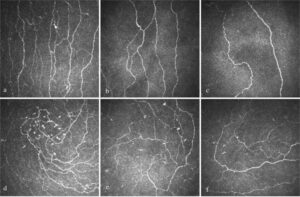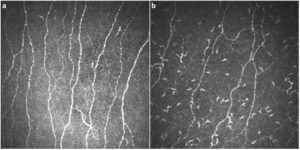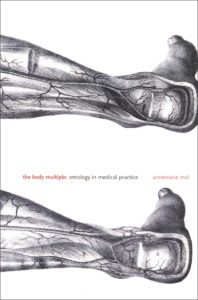
It might sound corny but it has long been said that our Eyes are the Window to our Soul. Whatever about the soul, every medical student gets told by ophthalmologists that the Eyes are the Window to the Body. They claim to be able to detect almost every possible disease by looking at our eyes.
Just over a decade ago, Corneal Confocal Microscopy (CCM) came into view. See CCM – a New Technique. CCM has been noted in RxISK posts – see Touching and Kissing but it is worth updating as it has been developing rapidly and the findings are exciting.
The Cornea is seems may be the best Window to the Body or at least the Peripheral Nervous System. It is a densely innervated, competing with or beating lips and genitals, as the most densely innervated part of the body.
The nerves can be seen and assessed by microscope. This means that nerve fiber length and density can be measured by non-invasive imaging. In most studies, nerve fiber counts in the cornea are generally correlated with skin biopsies, and correlate well with clinical symptoms of small fiber neuropathy.
Crucially it has an extensive innervation by Small or C fibres, the kind of nerves affected in Diabetes or by Drugs like chemotherapy both of which are widely accepted to cause peripheral neuropathy. This is important because electrophysiology tests and Quantitative Sensory Threshold tests – which has been one of RxISK’s favorite methods, primarily test large fibres.
Quantitative Sensory Threshold Testing has another factor working against it as far as neurologists are concerned – it is too subjective. Counting nerve fibres look much more objective (see Body Multiple note below).
Tests like ankle biopsies for Small Fibre Neuropathy are invasive, take time to do and to get results and at present the normal range was set using older subjects who have very clear peripheral neuropathies affecting their feet, and younger people with neuropathy may fall within the normal range for older people.
CCM is non-invasive, takes 10 minutes to do, and can give results pretty well straight away.
This makes it very easy to do on multiple occasions. So it could be used to track the regrowth of nerves if we find some treatment that stimulates regeneration.
Another benefit is that it appears that inflammatory processes increase the number of what are called dendritic cells – on the right in the image below – while drug induced toxicity is more likely to reduce nerve fibre density and length.
This might make it possible to decide if PSSD, PFS or related conditions are inflammatory and potentially helped by treatments like Intravenous Immunoglobulin – IVIG – or whether they result from toxicity in which case a regenerative drug would be a better option.
The dendritic cells – the spots – can be seen in the right hand image here.
CCM might also offer a way to work out who is likely to get PSSD or protracted withdrawal problems. There is a real likelihood that for many people the SSRI they are on has caused a loss of nerve fibres or an inflammatory process and this is linked to PSSD or enduring withdrawal.
This might put people on treatment in a position to know beforehand whether withdrawal might be relatively unproblematic and especially PSSD free or a more difficult process that might include PSSD. Facing a difficult process is grim but might be slightly easier for people who know what they are dealing with from the start.
Current studies for instance show that those who are going to get a peripheral neuropathy on cancer chemotherapy or with diabetes are more likely to show Corneal nerve loss or damage early on.
Moving Forward
It would be great if readers can research whether there is an Optometry, Ophthalmology, Neurology or Neuro-ophthalmology clinic near them that does CCM. If you find one, can you let us know and we will compile a list.
The next step will be to see if we can match 5 or so people with PSSD, PFS or PRSD to a clinic near them and see if they can get tested there on a proof of concept basis. Proof of concept means does the person in the clinic see changes worth pursuing.
Finding a clinic or person, willing to see 5 or so people, will need an overture from RxISK, or the person close to the clinic, or both, to see whether the clinic will accept a referral on the basis of the person’s doctor or a RxISK referral and what the charge might be.
Early overtures from someone doing a lot of work on this suggests that many centres will want a referral from an ophthalmologist. Many ophthalmologists, and neurologists, are unlikely to think PSSD has anything to do with them.
Giving them the RxISK vision paper might stimulate their interest and the other criteria, and clinical symptoms papers, which will be linked to a forthcoming post may help. The vision paper shows that some people with PSSD have vision problems also, and some without PSSD have a vision problem that comes on after stopping the drug and can persist for years – in other words a visual equivalent to PSSD.
Getting a group of people with Post SSRI Vision Disorders – with our without PSSD – may be of great interest to optometrists and ophthalmologists and might en route shed light on PSSD.
The hope is to do what we wanted to do in Sheffield but which seems to have fallen through – See SFN Investigation runs into Problems. In order to make a referral, we will need to screen people – getting them to fill questionnaires – to establish whether there are any more symptoms of neuropathy besides a genital neuropathy.
An optometry department may also have details about visual issues they may need to know about. People who have had Lasix Treatment on their eyes may not be suitable for CCM.
If the concept works out, and there are changes worth pursuing, then we will likely need a research grant to establish normal ranges for the variety of nerve factors that CCM can reveal – there are many more options than just the number of nerve endings that are counted in SFN biopsies of skin around the ankle.
CCM Facilities
We already have details including email contacts for clinics offering CCM in:
Australia and New Zealand
- Sydney
- Melbourne
- Brisbane
- Auckland
USA & Canada
- Southwestern H
- UCLA
- Harvard
- Miami
- Dallas UTSW hospital
- U Michigan
- U Toronto
- U Waterloo
- Montreal – coming soon
Europe
- Heidelberg Germany
- Rostock Germany
- Dresden Germany
- Munich Germany
- Linkopping Sweden
- Lausanne Switzerland
- Valladolid Spain
- Bilbao Spain
- Milan Italy
Britain
- Manchester England
- Exeter England
- Birmingham England
- London – Moorfields – England
- Bristol
People with PSSD, PFS and PRSD are desperate. This led many people to get in touch with Sheffield and swamp the clinic there both in terms of numbers and the desperation they could handle. This wrecked things for everyone.
It is in no one’s interest to have a repeat, particularly in terms of a test that may not yield the results we want. There is already one person with convincing PSSD who has had a negative test result. This may be a matter of a clinic needing to work out exactly what it is looking for rather than CCM not working.
In about 3 weeks time, we will be looking for people who might live near one of the centres above. There is a lot of work to do in RxISK in the meantime – contacting clinics and finding out if they would take a group of 5 people to test and if so what else is needed before this can happen .
The Body Multiple
It was noted above that counting nerve fibres looks much better to doctors and most people than listening to experiences. In a great book called The Body Multiple, Annemarie Mol tackles this issue, looking at clotting and plaques in legs.
These show up beautifully on X-ray and it is easy to see who is very badly affected with a minimal amount of blood getting through their arteries to their leg muscles which we need blood for walking. Others do not seem to have much blockage.
The reason the X-rays get done is because people complain about pain on walking – this is called intermittent claudication. Some people can’t walk very far because of the pain. You would expect that it is these people who have the most blocked arteries. And if that were so the answer seems clear, these are the ones who need an operation to unblock their arteries.
But in fact it can be just the opposite. Some people with pretty open arteries complain bitterly of pain, while those with blocked arteries may not. Walking generally, and gradually increasing the lengths of walks, seems to help some people as much as surgery – which can leave some people not much better.
So even X-Rays may not be a Window to the Body and CCM, which may be one of the best techniques so far for looking at C-fibres, may not be the Window to all problems that affect Genitals and Soles.



Patricia says
Bilbao( north-Spain)
Anmy says
Dear Dr. Healy,
Prof. Dr. med. Elisabeth Messmer (http://www.profkampik-muenchen.de/cms/website.php?id=/de/index/%C3%BCberuns/%C3%A4rzteteam/profmessmer.htm) is a Doctor working together with the LMU (University Munich) on Corneal in vivo microscopy. I hope I got it right that this is the same as CCM.
If she is a possible contact, please also reach out to me as well, as I am close to the location and my wife is a pssd sufferer with potential SFN.
Dr. David Healy says
A
Thanks for this Munich contact.
I don’t know if these are the same tests but look like they might be. We aren’t contacting anyone at the moment until we see if we can find roughly 5 people who live close to a clinic that does CCM and is willing to see 5 people on a proof of concept basis.
D
Bernard says
The following paper from 2017: https://www.researchgate.net/publication/317424518_Use_of_Corneal_Confocal_Microscopy_to_Evaluate_Small_Nerve_Fibers_in_Patients_With_Human_Immunodeficiency_Virus
says that the Moorfields Eye Hospital NHS Foundation Trust in London has made in vivo corneal confocal microscopy.
Their website (https://www.moorfields.nhs.uk/) is not very helpful to understand if they are currently doing that.
Dr. David Healy says
B
Thanks for this – someone else has found out about this and is chasing Moorfields
D
Bernard says
There is a university in Belgium that seems to have the required equipment, but for research purposes:
https://www.uhasselt.be/en/onderzoeksgroepen-en/advanced-optical-microscopy-centre
Would this be relevant? (I live between Brussels and London)
Dr. David Healy says
B
Sounds like you are on a houseboat then. No this would not work yet.
To get this to work properly we need an optometrist who is really onside. Most wil do it if you pay them but doing it and really looking for something distinctive to PSSD. This means they have to start thinking about the problem
and get curious and the same person likely needs to see a few – maybe 5 people – who may all look vaguely normal but after you’ve seen 5 you might spot a pattern that is not quite normal.
This will require liaison with whoever, giving them the SSRI and vision paper, getting them interested. We may have to discuss with a few centres and then pick the centre that is showing interest to do more than just do a test
If you do a test and they don’t what they are looking for and they return a negative result you might sabotage something for others that could be useful
David
Jose Fdez says
Hello,
Can you share the CCM Facilities of Valladolid (Spain) please ?
Thanks in advance
Dr. David Healy says
Its IOBA Valladolid, contact Maria Gonzalez mjgonzalez.ioba@gmail.com
But you should wait till we get the results of a CCM study taking place in Exeter.
There is no point just getting normal CCM done – it will turn out to be normal
Whoever does the test needs to be told what to look for – if we can establish that there is something to look for
David